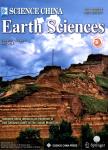Response of needle dark respiration of Pinus koraiensis and Pinus sylvestriformis to elevated CO_2 concentra-tions for four growing seasons’ exposure
Response of needle dark respiration of Pinus koraiensis and Pinus sylvestriformis to elevated CO_2 concentrations for four growing seasons’ exposure作者机构:Institute of Applied EcologyChinese Academy of SciencesShenyang 110016China Shenyang Agricultural UniversityShenyang 110161China
出 版 物:《Science China Earth Sciences》 (中国科学(地球科学英文版))
年 卷 期:2007年第50卷第4期
页 面:613-619页
基 金:Supported by the National Natural Science Foundation of China (Grant No. 30400051) the National Basic Research Program of China (Grant No. 2002CB412502) the Key Program of the National Natural Science Foundation of China (Grant No. 90411020)
主 题:elevated CO2 concentration long-term short-term dark respiration Pinus koraiensis Pinus sylvestriformis
摘 要:The long-term effect of elevated CO2 concentrations on needle dark respiration of two coniferous spe- cies—Pinus koraiensis and Pinus sylvestriformis on the Changbai Mountain was investigated using open-top chambers. P. koraiensis and P. sylvestriformis were exposed to 700, 500 μmol·mol-1 CO2 and ambient CO2 (approx. 350 μmol·mol-1) for four growing seasons. Needle dark respiration was meas- ured during the second, third and fourth growing seasons’ exposure to elevated CO2. The results showed that needle dark respiration rate increased for P. koraiensis and P. sylvestriformis grown at elevated CO2 concentrations during the second growing season, could be attributed to the change of carbohydrate and/or nitrogen content of needles. Needle dark respiration of P. koraiensis was stimu- lated and that of P. sylvestriformis was inhibited by elevated CO2 concentrations during the third growing season. Different response of the two tree species to elevated CO2 mainly resulted from the difference in the growth rate. Elevated CO2 concentrations inhibited needle dark respiration of both P. koraiensis and P. sylvestriformis during the fourth growing season. There was consistent trend be- tween the short-term effect and the long-term effect of elevated CO2 on needle dark respiration in P. sylvestriformis during the third growing season by changing measurement CO2 concentrations. How- ever, the short-term effect was different from the long-term effect for P. koraiensis. Response of dark respiration of P. koraiensis and P. sylvestriformis to elevated CO2 concentrations was related to the treatment time of CO2 and the stage of growth and development of plant. The change of dark respiration for the two tree species was determined by the direct effect of CO2 and long-term acclimation. The prediction of the long-term response of needle dark respiration to elevated CO2 concentration based on the short-term response is in dispute.



